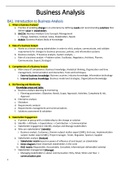Resume
Business Analysis summary of all the slides and courses + extensive summary of all the business modelling languages at the end
- Cours
- Business Analysis
- Établissement
- Katholieke Universiteit Leuven (KU Leuven)
Summary of everything from the courses and the slides, the document covers all the chapters and classes of the course business analysis.
[Montrer plus]



